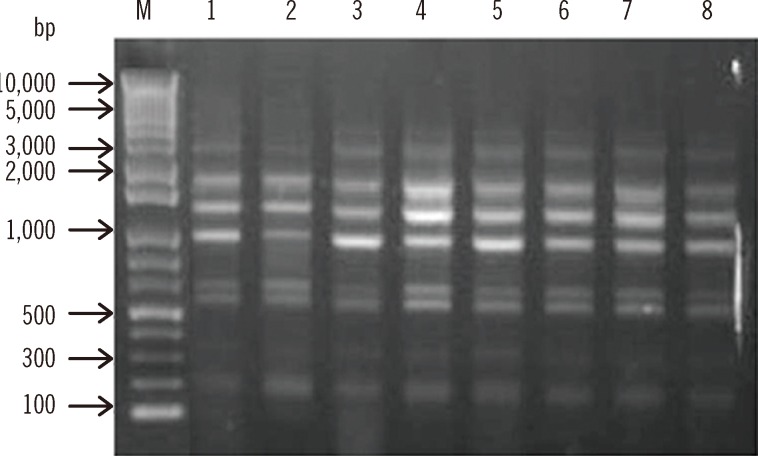Ann Lab Med.
2013 Jul;33(4):279-282. 10.3343/alm.2013.33.4.279.
Nosocomial Infection by Sequence Type 357 Multidrug-Resistant Acinetobacter baumannii Isolates in a Neonatal Intensive Care Unit in Daejeon, Korea
- Affiliations
-
- 1Department of Biomedical Laboratory Science, Far East University, Eumseong, Korea.
- 2Department of Laboratory Medicine, College of Medicine, Chungnam National University, Daejeon, Korea. shkoo@cnu.ac.kr
- 3Department of Biomedical Laboratory Science, Jeonju Kijeon College, Jeonju, Korea.
- KMID: 1707236
- DOI: http://doi.org/10.3343/alm.2013.33.4.279
Abstract
- Acinetobacter baumannii is an important microorganism responsible for a number of nosocomial outbreaks, in particular, in intensive care units (ICUs). We investigated a nosocomial infection caused by multidrug-resistant (MDR) A. baumannii in a neonatal intensive care unit (NICU) in Korea. A. baumannii isolates were characterized using Etest (AB Biodisk, Sweden), two multiplex PCR assays, and multilocus sequence typing (MLST) scheme. PCR and PCR mapping experiments were performed for detecting and characterizing the determinants of antimicrobial resistance. Eight strains isolated from an NICU belonged to European (EU) clone II and revealed only one sequence type (ST), namely, ST357. All the isolates were susceptible to imipenem but were resistant to amikacin, gentamicin, ceftazidime, cefepime, and ciprofloxacin. To the best of our knowledge, this is the first report of a nosocomial infection in an NICU in Korea caused by ST357 MDR/carbapenem-susceptible A. baumannii strains. This result demonstrates that nosocomial outbreaks of MDR/carbapenem-susceptible strains as well as MDR/carbapenem-resistant isolates may occur in NICUs.
MeSH Terms
-
Acinetobacter Infections/diagnosis/*microbiology
Acinetobacter baumannii/drug effects/genetics/*isolation & purification/metabolism
Anti-Bacterial Agents/pharmacology
Bacterial Proteins/genetics
Cross Infection/*microbiology
DNA, Bacterial/analysis
*Drug Resistance, Multiple, Bacterial
Humans
Imipenem/pharmacology
Infant, Newborn
*Intensive Care Units, Neonatal
Microbial Sensitivity Tests
Multilocus Sequence Typing
Multiplex Polymerase Chain Reaction
Republic of Korea
Anti-Bacterial Agents
Bacterial Proteins
DNA, Bacterial
Imipenem
Figure
Reference
-
1. Peleg AY, Seifert H, Paterson DL. Acinetobacter baumannii: emergence of a successful pathogen. Clin Microbiol Rev. 2008; 21:538–582. PMID: 18625687.2. Wisplinghoff H, Edmond MB, Pfaller MA, Jones RN, Wenzel RP, Seifert H. Nosocomial bloodstream infections caused by Acinetobacter species in United States hospitals: clinical features, molecular epidemiology, and antimicrobial susceptibility. Clin Infect Dis. 2000; 31:690–697. PMID: 11017817.3. Villegas MV, Hartstein AI. Acinetobacter outbreaks, 1977-2000. Infect Control Hosp Epidemiol. 2003; 24:284–295. PMID: 12725359.4. Garnacho-Montero J, Ortiz-Leyba C, Fernández-Hinojosa E, Aldabó-Pallás E, Cayuela A, Marguez-Vácaro E, et al. Acinetobacter baumannii ventilator-associated pneumonia: epidemiological and clinical findings. Intensive Care Med. 2005; 31:649–655. PMID: 15785929.5. Touati A, Achour W, Cherif A, Hmida HB, Afif FB, Jabnoun S, et al. Outbreak of Acinetobacter baumannii in a neonatal intensive care unit: antimicrobial susceptibility and genotyping analysis. Ann Epidemiol. 2009; 19:372–378. PMID: 19364663.6. Gundi VA, Dijkshoom L, Burignat S, Raoult D, La Scola B. Validation of partial rpoB gene sequence analysis for the identification of clinically important and emerging Acinetobacter species. Microbiology. 2009; 155:2333–2341. PMID: 19389786.7. Clinical and Laboratory Standards Institute. Performance standards for antimicrobial susceptibility testing. Fifteenth Informational supplement, M100-S20. Wayne, PA: Clinical and Laboratory Standards Institute;2010.8. Turton JF, Gabriel SN, Valderrey C, Kaufmann ME, Pitt TL. Use of sequence-based typing and multiplex PCR to identify clonal lineages of outbreak strains of Acinetobacter baumannii. Clin Microbiol Infect. 2007; 13:807–815. PMID: 17610600.9. Bartual SG, Seifert H, Hippler C, Luzon MA, Wisplinghoff H, Rodríguez-Valera F. Development of a multilocus sequence typing scheme for characterization of clinical isolates of Acinetobacter baumannii. J Clin Microbiol. 2005; 43:4382–4390. PMID: 16145081.10. Bou G, Cerveró G, Domínguez MA, Quereda C, Martínez-Beltrán J. PCR-based DNA fingerprinting (REP-PCR, AP-PCR) and pulsed-field gel electrophoresis characterization of a nosocomial outbreak caused by imipenem- and meropenem-resistant Acinetobacter baumannii. Clin Microbiol Infect. 2000; 6:635–643. PMID: 11284921.11. Koo SH, Kwon KC, Cho HH, Sung JY. Genetic basis of multidrug-resistant Acinetobacter baumannii clinical isolates from three university hospitals in Chungcheong Province, Korea. Korean J Lab Med. 2010; 30:498–506. PMID: 20890082.12. Cho YJ, Moon DC, Jin JS, Choi CH, Lee YC, Lee JC. Genetic basis of resistance to aminoglycosides in Acinetobacter spp. and spread of armA in Acinetobacter baumannii sequence group 1 in Korean hospitals. Diagn Microbiol Infect Dis. 2009; 64:185–190. PMID: 19361944.13. Zhou Y, Yu H, Guo Q, Xu X, Ye X, Wu S, et al. Distribution of 16S rRNA methylases among different species of Gram-negative bacilli with high-level resistance to aminoglycosides. Eur J Clin Microbiol Infect Dis. 2010; 29:1349–1353. PMID: 20614151.
Article14. Akasaka T, Tanaka M, Yamaguchi A, Sato K. Type II topoisomerase mutations in fluoroquinolone-resistant clinical strains of Pseudomonas aeruginosa isolated in 1998 and 1999: role of target enzyme in mechanism of fluoroquinolone resistance. Antimicrob Agents Chemother. 2001; 45:2263–2268. PMID: 11451683.15. Valentine SC, Contreras D, Tan S, Real LJ, Chu S, Xu HH. Phenotypic and molecular characterization of Acinetobacter baumannii clinical isolates from nosocomial outbreaks in Los Angeles County, California. J Clin Microbiol. 2008; 46:2499–2507. PMID: 18524965.16. McGrath EJ, Chopra T, Abdel-Haq N, Preney K, Koo W, Asmar BI, et al. An outbreak of carbapenem-resistant Acinetobacter baumannii infection in a neonatal intensive care unit: investigation and control. Infect Control Hosp Epidemiol. 2011; 32:34–41. PMID: 21091204.
- Full Text Links
- Actions
-
Cited
- CITED
-
- Close
- Share
- Similar articles
-
- Multidrug-resistant Acinetobacter baumannii infection in the intensive care unit
- Extreme Drug Resistant Acinetobacter Nosocomial Ventilator-Associated Pneumonia Treated Successfully with Tigecycline and Amikacin in Intensive Care Unit: A Case Report
- Clinical and Molecular-epidemiologic Analysis of A Nosocomial Outbreak of Acinetobacter baumannii in a Neonatal Intensive Care Unit
- Dissemination of an AbaR-type Resistance Island in Multidrug-resistant Acinetobacter baumannii Global Clone 2 in Daejeon of Korea
- Outbreak of Acinetobacter septicemia in a neonatal intensive care unit


